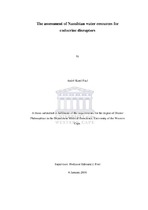| dc.description.abstract | Namibia is the driest sub-Saharan country in Africa and it is characterised by low
and variable rainfall. As a result, potable water in this mostly semi-arid country is
considered an extremely valuable resource. Given the variety of anthropogenic
and natural chemicals released into the environment by a growing human
population, many water resources worldwide present health risks to both man and
wildlife. Many of these chemicals are classified as endocrine disruptors which are
chemicals with the ability to adversely affect the physiological systems regulated
by the endocrine systems of organisms. These include, among others,
reproductive, neurological and immunological effects. Endocrine disrupting
chemicals include: natural and synthetic hormones such as estrogen, estrone,
estriol and testosterone; heavy metals such as tri-butyltin, lead and cadmium;
pesticides such as organophosphates and organochlorides; and a number of
compounds such as polycyclic aromatic hydrocarbons and polychlorinated
biphenyls. | |

